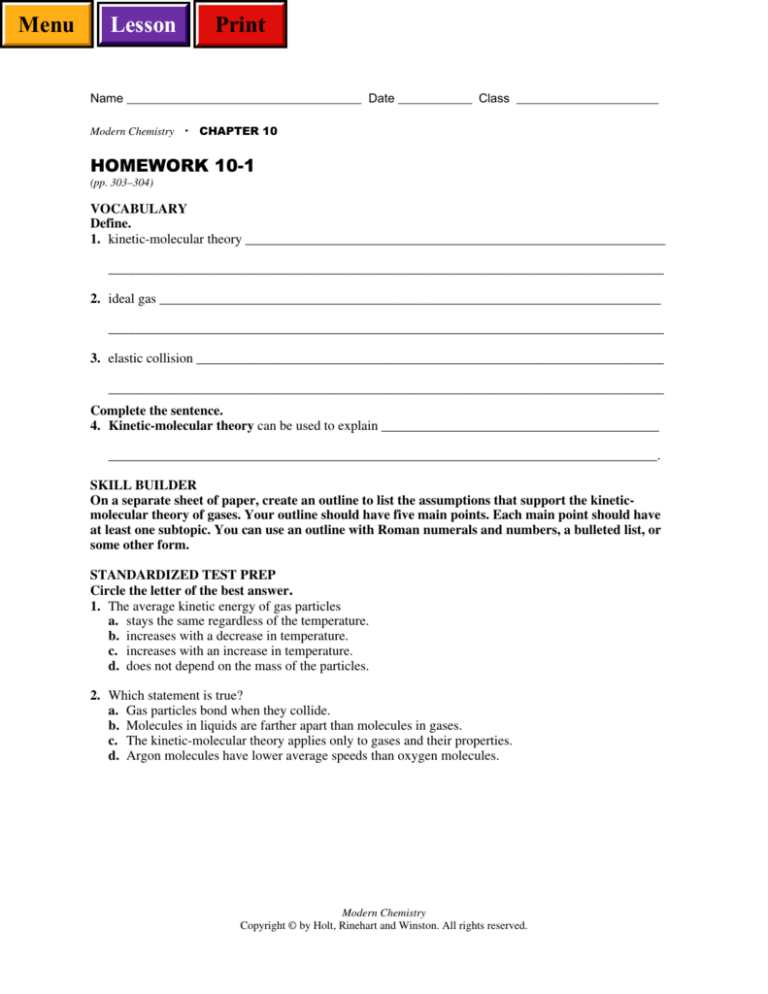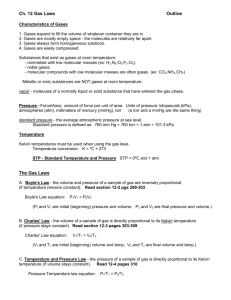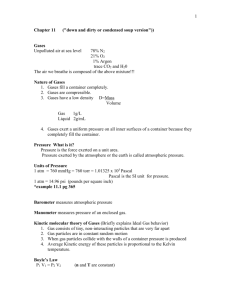
Menu
Lesson
Print
Name ______________________________________ Date ____________ Class _______________________
Modern Chemistry • CHAPTER 10
HOMEWORK 10-1
(pp. 303–304)
VOCABULARY
Define.
1. kinetic-molecular theory ______________________________________________________________
__________________________________________________________________________________
2. ideal gas __________________________________________________________________________
__________________________________________________________________________________
3. elastic collision _____________________________________________________________________
__________________________________________________________________________________
Complete the sentence.
4. Kinetic-molecular theory can be used to explain _________________________________________
_________________________________________________________________________________.
SKILL BUILDER
On a separate sheet of paper, create an outline to list the assumptions that support the kineticmolecular theory of gases. Your outline should have five main points. Each main point should have
at least one subtopic. You can use an outline with Roman numerals and numbers, a bulleted list, or
some other form.
STANDARDIZED TEST PREP
Circle the letter of the best answer.
1. The average kinetic energy of gas particles
a. stays the same regardless of the temperature.
b. increases with a decrease in temperature.
c. increases with an increase in temperature.
d. does not depend on the mass of the particles.
2. Which statement is true?
a. Gas particles bond when they collide.
b. Molecules in liquids are farther apart than molecules in gases.
c. The kinetic-molecular theory applies only to gases and their properties.
d. Argon molecules have lower average speeds than oxygen molecules.
Modern Chemistry
Copyright © by Holt, Rinehart and Winston. All rights reserved.
Menu
Print
Lesson
Name ______________________________________ Date ____________ Class _______________________
Modern Chemistry • CHAPTER 10
HOMEWORK 10-2
(pp. 305–307)
VOCABULARY
Complete each sentence.
1. Liquids and gases are alike because ____________________________________________________.
2. Diffusion is ______________________________________________________________________.
3. The density of a substance in a gaseous state is much less than its density in liquid or solid state
because __________________________________________________________________________.
4. The rate of diffusion of one gas through another depends on _______________________________.
5. The process by which gas particles under pressure pass through a tiny opening is called __________
_________________________________________________________________________________.
6. A real gas is ______________________________________________________________________.
SKILL BUILDER
Circle the three gases that you would expect to behave most like ideal gases.
Kr
NH3
H2O
O2
SO2
Ne
Circle the three gases that you would expect to deviate most from ideal behavior.
HCl
CO2
Rn
Ar
N2H4
H2
Assume that the gases in each pair are allowed to mix with each other at the same temperature.
Circle the gas that will diffuse more rapidly.
1. Kr
NH3
2. H2O
N2H4
3. Ne
Kr
4. CO2
SO2
5. PCl3
C4H10
STANDARDIZED TEST PREP
Circle the letter of the best answer.
1. Which is not true about gases?
a. Gases expand to fill their containers.
b. Gas particles mix with other gas particles in random patterns.
c. Gases are generally less dense than solids.
d. Gas particles move rapidly without significant attraction or repulsion between particles.
2. Which of these gases will effuse more quickly than CO?
a. Xe
b. O2
c. C3H8
d. Ne
Modern Chemistry
Copyright © by Holt, Rinehart and Winston. All rights reserved.
Menu
Lesson
Print
Name ______________________________________ Date ____________ Class _______________________
Modern Chemistry • CHAPTER 10
HOMEWORK 10-3
(pp. 308–310)
VOCABULARY
Answer each question.
1. How is pressure defined? ____________________________________________________________
2. Write the formula for pressure. _______________________________________________________
3. What is the SI unit for force? What does that SI unit measure? _______________________________
_________________________________________________________________________________
4. What does a barometer measure? _____________________________________________________
5. On what does specific atmospheric pressure depend? ____________________________________
_________________________________________________________________________________
GRAPHIC ORGANIZER
Using an additional sheet of paper, make a K-W-L Chart similar to the one below to record your
ideas about the physical characteristics of gases. In the K column, write what you already know,
both from your prior knowledge and the first section of this chapter. In the W column, write what
you want to know about the physical characteristics of gases. Finally, in the L column, record the
answers to your questions as you read. You may not be able to answer all of your questions.
Continue working on your K-W-L chart as you read the rest of Chapter 10.
K
What I Know
The Physical Characteristics of Gases
W
What I Want to Know
L
What I’ve Learned
STANDARDIZED TEST PREP
Circle the letter of the best answer.
1. What conditions are required so that the average pressure of the atmosphere supports a 760 mm
column of mercury?
a. altitude of 0 km, 0ºC
b. altitude of 0 km, 0ºF
c. altitude of 0 km, any temperature
d. any altitude, 0ºC
2. If two equal forces are applied to two different areas, which statement is true?
a. The force that is applied to a smaller area results in less pressure.
b. The pressure on the two areas will be the same, regardless of their size.
c. The force that is applied to a larger area results in less pressure.
d. The force that is applied to a smaller area results in a lower temperature.
Modern Chemistry
Copyright © by Holt, Rinehart and Winston. All rights reserved.
Menu
Lesson
Print
Name ______________________________________ Date ____________ Class _______________________
Modern Chemistry • CHAPTER 10
HOMEWORK 10-4
(pp. 311–312)
VOCABULARY
Select the term in Column B that matches the expression in Column A.
Column A
Column B
1. pressure formula _____
a. 1 N/m2
2. millimeters of mercury _____
b. mm Hg
3. Pascal _____
c. force/area
4. 1 atmosphere _____
d. 760 mm Hg
5. STP _____
e. 1 atm, 0ºC
SKILL BUILDER
Fill in the chart by supplying the missing quantities. Use conversion factors to convert data in
atmospheres, mm Hg, and kPa. Show four significant figures in your answers.
Pressure in atm
Pressure in mm Hg
Pressure in kPa
0.943
1345.21
79.64
1029.8
0.546
STANDARDIZED TEST PREP
Circle the letter of the best answer.
1. The mercury in a barometer falls until
a. the pressure exerted by its weight is equal to the pressure exerted by the atmosphere.
b. the diameter of the mercury tube is increased.
c. the pressure exerted by its weight is less than the pressure exerted by the atmosphere.
d. a barometer is placed at an elevation lower than sea level.
2. Each item shows common units of measurement in chemistry. In which item are all of the units shown
used to express pressure measurements?
a. Pa, kPa, atm, kg
b. kPa, torr, km, K
c. atm, torr, mm Hg, Pa
d. torr, N, mm Hg, kJ
Modern Chemistry
Copyright © by Holt, Rinehart and Winston. All rights reserved.
Menu
Lesson
Print
Name ______________________________________ Date ____________ Class _______________________
Modern Chemistry • CHAPTER 10
HOMEWORK 10-5
(pp. 313–315)
VOCABULARY
Define.
1. gas laws ___________________________________________________________________________
__________________________________________________________________________________
2. Boyle’s law ________________________________________________________________________
__________________________________________________________________________________
Write two equations that express Boyle’s law.
Write three equations that can be used to calculate values when comparing changing conditions for
a gas.
SKILL BUILDER
On a separate sheet of paper, solve the following problems.
1. A gas occupies 14.5 L at a pressure of 0.526 atm. What is the volume when the pressure is increased
to 0.780 atm?
2. If a gas occupies 5.40 L at a pressure of 1.25 atm, what will be its volume at a pressure of 3.00 atm?
3. A gas occupies 250 L at 101.325 kPa. What will be the pressure if the gas is compressed to fill a
12.5 L tank?
4. 560.0 mL of a gas is under a pressure of 735.0 torr. What would the volume of the gas be at a pressure
of 935.0 torr?
5. A 3.50-L flask is filled with nitrogen at a pressure of 16.0 atm. What size flask would be required to
hold this gas at a pressure of 4.00 atm?
STANDARDIZED TEST PREP
Circle the letter of the best answer.
1. A graph of volume vs. pressure for a gas at constant temperature yields a
a. curved line.
b. straight line.
c. series of random points.
d. hyperbola.
2. The equation P1V1 = P2V2 can be used only for systems in which
a. the gases involved are noble gases.
b. the volumes are measured in mL.
c. the temperature is held constant.
d. the gases involved are ideal gases.
Modern Chemistry
Copyright © by Holt, Rinehart and Winston. All rights reserved.
Menu
Print
Lesson
Name ______________________________________ Date ____________ Class _______________________
Modern Chemistry • CHAPTER 10
HOMEWORK 10-6
(pp. 316–319)
VOCABULARY
Define.
1. absolute zero _______________________________________________________________________
__________________________________________________________________________________
2. Charles’s law ______________________________________________________________________
__________________________________________________________________________________
Answer each question on a separate sheet of paper.
3. Write an equation you can use to convert degrees Celsius to kelvins.
4. Write two equations that express Charles’s law.
5. Why is it important to use kelvins when measuring temperature for gas law calculations?
GRAPHIC ORGANIZER
Complete the table of volume–temperature data for a gas sample held at constant mass and
pressure. Then graph your results.
k
3
3
3
3
3
3
3
Volume (L)
1.5
Kelvin Temperature (K)
3.0
4.13
14.8
19.5
24.6
8.20
9.63
44.0
STANDARDIZED TEST PREP
Circle the letter of the best answer.
1. A 450.0-mL sample of oxygen is warmed from 45.0°C to 73.5°C. If its pressure remains constant,
its volume will be
a. 275.5 mL
b. 413.0 mL
c. 490.3 mL
d. 735.0 mL
2. If the Kelvin temperature of a gas is doubled, the volume of the gas will
a. be cut in half.
b. stay the same.
c. double.
d. quadruple.
Modern Chemistry
Copyright © by Holt, Rinehart and Winston. All rights reserved.
Menu
Lesson
Print
Name ______________________________________ Date ____________ Class _______________________
Modern Chemistry • CHAPTER 10
HOMEWORK 10-7
(pp. 319–322)
VOCABULARY
Define.
1. Gay-Lussac’s law __________________________________________________________________
_________________________________________________________________________________
2. combined gas law __________________________________________________________________
_________________________________________________________________________________
Answer each question.
3. Write two equations that express Gay-Lussac’s law. _______________________________________
____________________________________________________________________________________
4. Write two equations that express the combined gas law. ____________________________________
____________________________________________________________________________________
SKILL BUILDER
On an additional sheet of paper, solve the following problems.
1. At conditions of 640.5 torr and 23.00°C, a gas occupies a volume of 56.40 mL. What will be the
volume of the same gas at 782.0 torr and 32.00° C?
2. At a pressure of 740.0 mm Hg and 26.30°C, a certain gas has a volume of 462.0 mL. What will be the
volume of this gas at STP?
3. 3.300 L of nitrogen, originally at 28.00°C and 820.0 mm Hg, are heated until a volume of 18.00 L and
a pressure of 226.0 mm Hg are reached. What is the new temperature?
4. 78.00 mL of oxygen at STP are heated to 76.00°C. The volume increases to 3.650 L. What is the new
pressure?
5. A gas sample occupies 4.250 L at 39.00°C and 1725 mm Hg. At what temperature will the gas occupy
8430 mL at 1.00 atm?
STANDARDIZED TEST PREP
Circle the letter of the best answer.
1. A graph of pressure vs. temperature for a gas at constant volume yields
a. a curved line passing through the origin.
b. a hyperbola.
c. a straight line passing through the origin.
d. either a straight or curved line, depending on the value of k.
2. The action that happens when a balloon is squeezed best illustrates
a. Gay-Lussac’s law.
b. Boyle’s law.
c. Charles’s law.
d. the combined gas law.
Modern Chemistry
Copyright © by Holt, Rinehart and Winston. All rights reserved.
Menu
Lesson
Print
Name ______________________________________ Date ____________ Class _______________________
Modern Chemistry • CHAPTER 10
HOMEWORK 10-8
(pp. 322–325)
VOCABULARY
Complete each sentence.
1. The partial pressure of a gas is ________________________________________________________
_________________________________________________________________________________.
2. Dalton’s law of partial pressures states that ______________________________________________
_________________________________________________________________________________.
3. Charles’s law represents the relationship between _________________________________________
_________________________________________________________________________________.
4. Boyle’s law shows the relationship between ______________________________________________
_________________________________________________________________________________.
5. Gay-Lussac’s law represents the relationship between ______________________________________
_________________________________________________________________________________.
SKILL BUILDER
On an additional sheet of paper, solve the following problems.
1. A container holds helium, oxygen, and carbon monoxide gases. Their respective partial pressures are
3.00 atm, 1.50 atm, and 4.00 atm. What is the total pressure inside the container?
2. A container with two gases, hydrogen and argon, is 30.0% hydrogen by volume. Calculate the partial
pressures of hydrogen and argon if the total pressure inside the container is 5.00 atm.
3. Hydrogen gas is collected over water at 35°C. If the barometric pressure is 784.0 mm Hg, what is the
partial pressure of the hydrogen gas?
4. 275 mL of hydrogen is collected over water at 32°C and 1.4 atm. What is the pressure of the hydrogen
at STP?
STANDARDIZED TEST PREP
Circle the letter of the best answer.
1. In which of these situations does Dalton’s law of partial pressures not apply?
a. A gas is collected over water at STP.
b. One of the gases involved in the calculations is a noble gas.
c. The gases are involved in a chemical reaction.
d. Four or more gases are combined in one container.
2. Which statement about gases is not true?
a. The relationship between pressure and temperature at constant volume is directly proportional.
b. The four measurable quantities needed to fully describe a gas are pressure, volume, temperature,
and number of molecules.
c. The volume of a gas increases or decreases in direct proportion to the Celsius temperature.
d. The relationship between volume and pressure at constant temperature is inversely proportional.
Modern Chemistry
Copyright © by Holt, Rinehart and Winston. All rights reserved.









